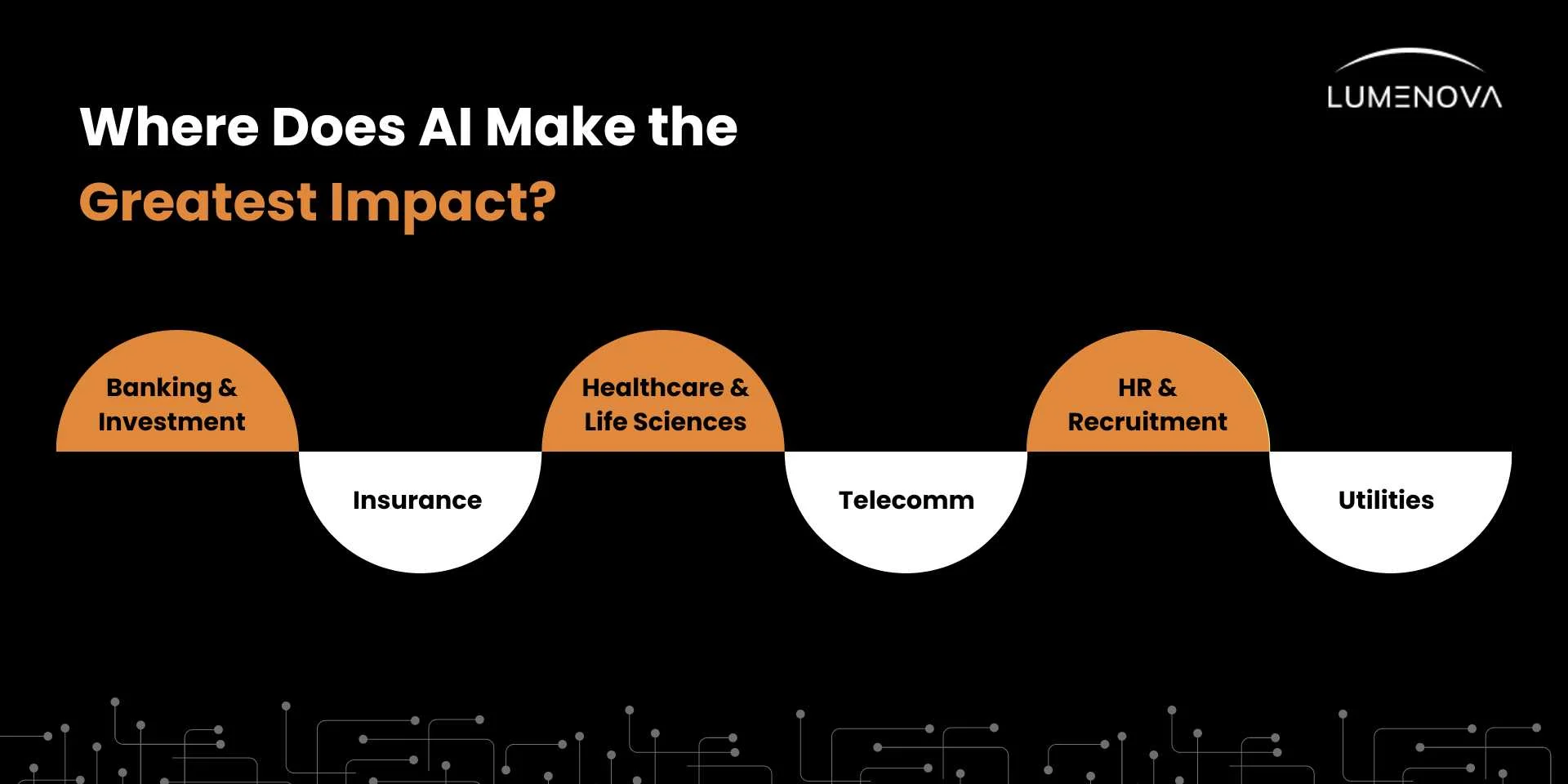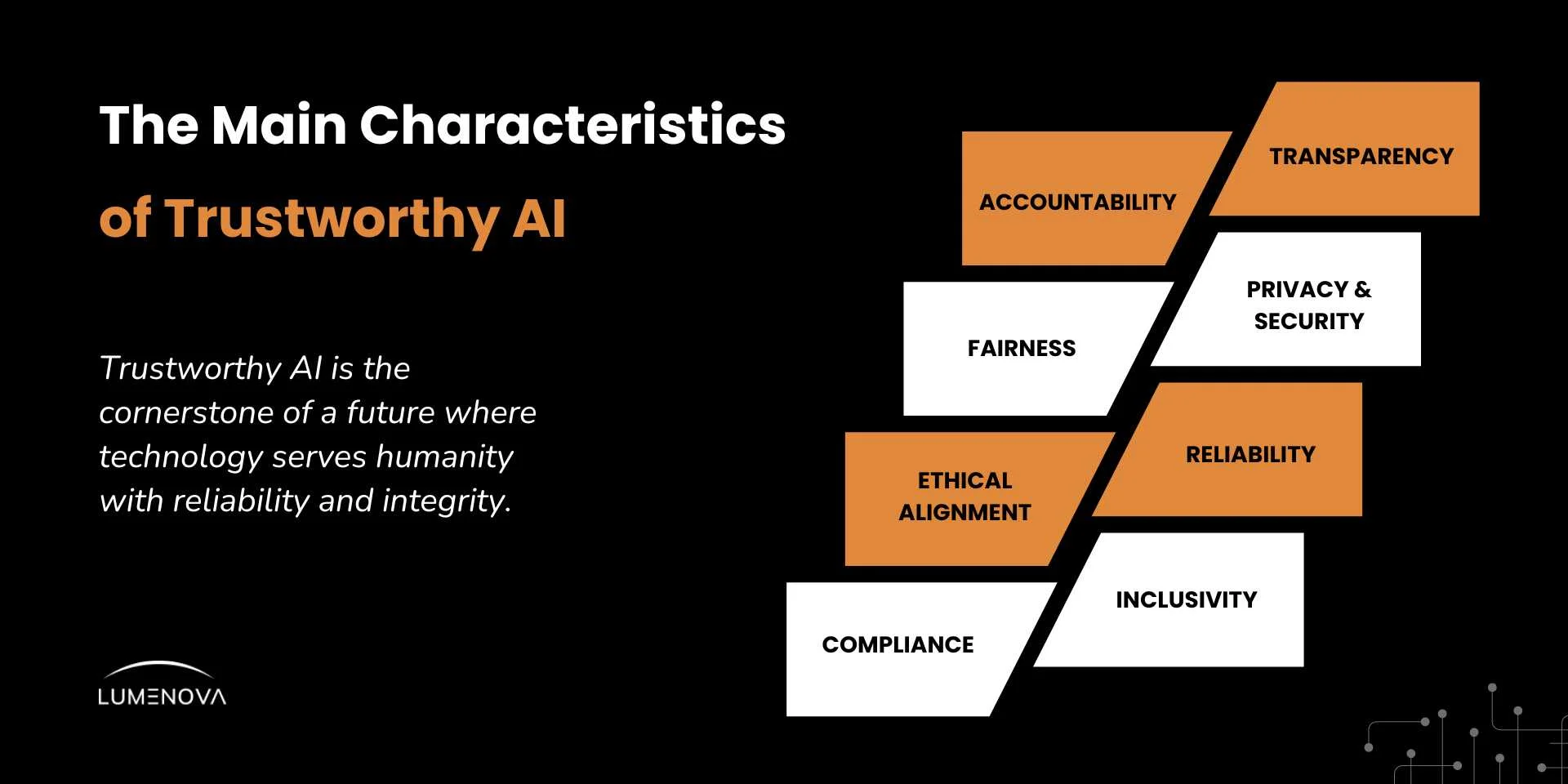
Contents
We’re already three months into 2024, and organizations worldwide actively seek to harness the power of artificial intelligence to create a brighter and more efficient future.
Early adopters of AI span various sectors, with notable emphasis in banking/finance, insurance, healthcare, HR, and heavily regulated industries like telecom and utilities.
Let’s delve deeper into the industries where AI has the most significant impact.
Where Does AI Hold the Greatest Significance?

A sector-specific breakdown reveals the following applications:
- Banking and Investments: AI systems can adjust credit scoring to assess creditworthiness, extending financial opportunities to underserved communities, while automating administrative tasks, streamlining workflows, and optimizing operational efficiency. In banking, AI fraud detection systems can identify suspicious activity, preventing financial losses and enhancing security while AI-based software reduces approval times for loans and credit facilities, improving customer satisfaction. Finally, AI can automate various tasks, such as document processing and verification, improving efficiency and reducing human error.
- Insurance: When it comes to this sector, an AI system could offer automation and security, claims processing and fraud detection, AI-Enhanced Interactive support (chatbots that provide 24/7 customer support), predictive maintenance for property insurance, and risk mitigation. Implementing AI algorithms for rapid underwriting decisions enables faster issuance of policies and enhances the customer experience. Finally, an insurance company can use AI to analyze policyholder data, predicting life events such as marriage or the birth of a child. AI predictive analysis can also be used for travel policies.
- Healthcare and Life Sciences: Using an AI system for storing medical data could help to diagnose diseases, predict health outcomes, and aid in the creation of personalized treatment plans such as X-rays, MRIs, and CT scans to assist in treatment planning. More emphasis is placed on the automation of administrative and operational tasks to analyze patient data, genetic information, and medical history, tailoring treatment plans and medications to individual patients. AI-driven systems could be developed to assist healthcare providers in making accurate diagnoses, selecting appropriate treatments, and predicting patient outcomes.
- Telecommunications: Implementing AI-powered voice recognition technology for voice-activated services, virtual assistants, and speech-to-text transcription and utilizing AI algorithms to analyze market demand can optimize network planning and expansion strategies. Applying AI models to analyze customer usage patterns, demographics, and interaction history helps to identify at-risk customers and implement targeted retention initiatives. Using AI to monitor and optimize Quality of Service (QoS) metrics such as network latency, jitter, and packet loss can ensure a consistent and reliable user experience.
- HR and Recruitment: HR departments benefit from using AI algorithms to analyze resumes, identify relevant skills and qualifications, source candidates from various online platforms, social media networks, and professional databases, and match them to job requirements in a matter of seconds. Leveraging AI to mitigate bias in the hiring process promotes diversity and inclusion by ensuring fair evaluation of candidates from diverse backgrounds. AI can also be used to assess skill gaps within the workforce, recommend training programs, forecast future workforce needs, identify high-potential employees, and develop succession plans for key roles.
- Utilities: Using AI algorithms can help predict equipment failures, optimize maintenance schedules, and prevent costly downtime in utility infrastructure. Leveraging AI to optimize energy distribution can improve grid efficiency by balancing supply and demand. AI models can perform accurate predictions of energy demand patterns, enabling utilities to optimize supply and pricing strategies, while employing AI algorithms to detect faults in utility infrastructure can identify outage causes and expedite restoration efforts. For example, AI-based fault detection systems can analyze real-time data from sensors and meters to identify potential issues, prioritize maintenance, and reduce downtime during outages.
The Main Characteristics of Trustworthy AI

Clearly, AI holds great power. However, what does it genuinely entail for AI to be responsible? Let’s examine the key attributes of reliable and trustworthy AI.
- Transparency: When working with AI models we should clearly understand how they work, what data they use, and the rationale behind AI-driven decisions. This transparency builds trust among users and stakeholders.
- Accountability: Organizations should have mechanisms to track and explain decisions made by AI systems, along with a chain of responsibility in case of errors or unintended consequences. This involves setting up clear protocols for human oversight.
- Fairness: AI systems should be designed to avoid biases and ensure equal treatment for all users. This involves continuous monitoring and updating to identify and correct biased outcomes.
- Privacy and Security: Protecting users’ data should be paramount. AI systems must include robust security measures to prevent unauthorized data access, alongside privacy controls that enable users to manage their data.
- Reliability: AI systems should operate consistently and predictably, delivering accurate results and maintaining uptime that meets or exceeds expectations.
- Ethical Alignment: The objectives and operations of AI models should be aligned with ethical principles that prioritize human values and well-being, adhering to guidelines such as those proposed by relevant bodies.
- Inclusivity: AI should be designed with diverse user groups in mind, ensuring that it isn’t biased or unfair in any way.
- Regulatory Compliance: AI models must adhere to all relevant laws and regulations (EU AI Act, Canadian AI and Data Act or NIST AI RMF), as well as those pertaining to data protection (like GDPR, HIPAA, etc.).
The Barriers of AI Adoption in 2024
It is well known that the adoption of AI involves intricate considerations spanning ethical, regulatory, and technical dimensions.
This is because, compared to conventional software systems, AI models are characterized by a higher level of unpredictability and ethical risk due to their autonomous and often opaque decision-making processes.
The emergence of Responsible AI (RAI) can be attributed to the increasing demand for AI models that are reliable and beneficial to humanity. The gap between AI implementation and responsible AI practices, if left unaddressed, often leaves companies vulnerable to regulatory, financial, reputational, and security risks.
Hence, implementing an enterprise-wide Responsible AI program is now, perhaps more than ever, a prerequisite for solid business operations.
Creating an Optimal Framework for Responsible AI
Embarking on the journey of Responsible AI is complicated and requires collaboration from various stakeholders. Implementing a robust, purpose-designed platform for Responsible AI can streamline your organization’s efforts, simplifying the complexities inherent in such initiatives. It can also bridge the gap often present between technical AI experts and the diverse spectrum of business leaders tasked with overseeing AI risk and compliance.
Translating technical metrics – the language of data scientists and Machine Learning engineers – into business-centric insights on risk and compliance poses a significant challenge. However, it’s essential for constructing a pragmatic framework for managing AI risks that aligns with broader policy and business needs.
While overcoming obstacles like the ones mentioned above is challenging, the Lumenova AI platform provides a holistic strategy to tackle these issues with precision.
Crafted to elevate the fairness, transparency, and responsibility of your AI systems, our platform ensures adherence to ethical standards and the promotion of accountability in decision-making processes.
How Lumenova AI Enables You to Achieve Trusted AI
With Lumenova AI you can:
- Automate the complete responsible AI lifecycle to meet business objectives faster, while ensuring a seamless collaboration among stakeholders.
- Assess risks in AI models during pre-deployment, avoiding reputational risks.
- Centralize model and data access management among divisions with granular permissions tools.
- Facilitate regulatory assurance through automated documentation fulfilled transparency.
- Preserve privacy while enabling full transparency for output watermarking and data lineage tracking.
- Continuously monitor emerging issues from models in production.
- Initiate specialized reviews of uncertain responses or impact assessments of unintended harms along with mitigation strategies.
Discover how Lumenova AI’s Responsible AI platform can help your organization navigate the complexities of AI deployment by requesting a demo, or contact our AI experts for more details.